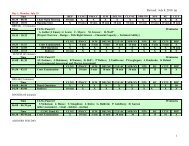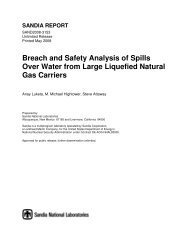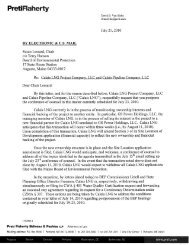Properties of LNG - Save Passamaquoddy Bay
Properties of LNG - Save Passamaquoddy Bay
Properties of LNG - Save Passamaquoddy Bay
- No tags were found...
Create successful ePaper yourself
Turn your PDF publications into a flip-book with our unique Google optimized e-Paper software.
<strong>Properties</strong> <strong>of</strong> <strong>LNG</strong>Don JuckettUS Department <strong>of</strong> EnergyFebruary 12, 2002<strong>LNG</strong> WorkshopSolomons, MDU.S. Department <strong>of</strong> Energy
U.S. Department <strong>of</strong> EnergyImports Will be an Important Source <strong>of</strong>Supplies to Satisfy Growing Demand40HistoryProjection3530Consumption25Consumption in Excess <strong>of</strong> Prduction2015Total Domestic Production10501995 1996 1997 1998 1999 2000 2001 2002 2003 2004 2005 2006 2007 2008 2009 2010
U.S. Department <strong>of</strong> EnergyGas Imports From Canada and <strong>LNG</strong> ImportsAre Projected to Grow As Sources <strong>of</strong> Supply5HistoryProjection4CanadaVolume (Trillion Cubic Feet)3210Liquified Natural GasMexico-11995 1996 1997 1998 1999 2000 2001 2002 2003 2004 2005 2006 2007 2008 2009 2010
U.S. <strong>LNG</strong> ImportFacilitiesU.S. Department <strong>of</strong> EnergyEverett <strong>LNG</strong> Import Facility- Massachusetts(Expansion underway)Cove Point <strong>LNG</strong> Facility - Maryland(Import capability currently being recommissioned)Lake Charles <strong>LNG</strong> Import Facility -Louisiana(Expansion underway)Elba Island <strong>LNG</strong> Import Facility - Georgia(Currently being re-started)
U.S. <strong>LNG</strong> ImportFacilitiesU.S. Department <strong>of</strong> EnergyCurrent CapacityLocationStatusSendout(MMcf/Day)Everett, MA Active 450100 by truckStorage(Bcf)Possible CapacityExpansion3.5 165 MMcf/d– sendoutLake Charles, LA Active 700 6.3 300 MMcf/d– sendoutElba Island, GACove Point, MDRestartingoperations• Active for Storage• Planned openingfor imports 2002440 4.1 360 MMcf/d– sendout1,0005.0 2.8 Bcf – storage(nameplate) 1Note: Except where noted, sendout capacity is <strong>LNG</strong> vaporization which is then shipped via pipeline1This is Cove Point’s nameplate capacity. Capacity for reopening has not yet been determined.
U.S. Department <strong>of</strong> Energy<strong>LNG</strong> Imports Projections by Receiving Facility300HistoryProjectionCove Point250Volume (Billion Cubic Feet)200150100EverettLake CharlesElba Island5001995 1996 1997 1998 1999 2000 2001 2002 2003 2004 2005 2006 2007 2008 2009 2010Cove Point, MD Everett, MA Lake Charles, LA Elba Island, GA
U.S. Department <strong>of</strong> Energy<strong>LNG</strong> Imports are a Key Element <strong>of</strong>U.S. Supplies• <strong>LNG</strong> Imports have grown by more than 2 and one-half timesbetween 1998 and 2000, from 85 Bcf to 224 Bcf• <strong>LNG</strong> imports are expected to grow from 1.3 percent <strong>of</strong> U.S.consumption to more than 3 percent by 2008• <strong>LNG</strong> imports can be quite significant on a regional basis• New greenfield projects <strong>of</strong>ten meet local resistance
U.S. Department <strong>of</strong> EnergyNatural Gas Imports & Exports, 1999 (BCF)Algeria76Australia12Japan<strong>LNG</strong>64Malaysia342Qatar3368206155<strong>LNG</strong>163Trinidad and Tobago51United ArabEmirates3
U.S. Department <strong>of</strong> EnergyNatural Gas Imports & Exports, 2000AustraliaAlgeria446IndonesiaNigeriaJapan<strong>LNG</strong>66753Oman13Qatar35441046Trinidad and Tobago10512<strong>LNG</strong>22399United Arab Emirates3
U.S. Department <strong>of</strong> Energy<strong>LNG</strong> and Natural Gas• Physical properties and behavior• Myth and Legend• Knowledge and Common Sense• Hazards -
<strong>LNG</strong> <strong>Properties</strong>U.S. Department <strong>of</strong> Energy• Liquefied Natural gas is a Cryogenic Liquid– <strong>LNG</strong> Density - 26.5 LB./Cu. Ft.• Lighter than water (65 LB/Cu. Ft.)– <strong>LNG</strong> Boiling point - (-259 o F)• Liquid Nitrogen - (-320 o F)• Liquid Oxygen - (-297 o F)
Natural Gas <strong>Properties</strong>U.S. Department <strong>of</strong> Energy• Natural gas is lighter than air– Natural Gas Density - 0.47• (Air - 1.0)• Natural gas rises under normal atmosphericconditions
U.S. Department <strong>of</strong> EnergyMyth and Legend• “Catastrophic release <strong>of</strong> <strong>LNG</strong> creates a BLEVE-- boiling liquid expanding vapor explosion”NOT TRUE– In laboratory and open ocean combustion tests,there have been no documented cases <strong>of</strong> <strong>LNG</strong>BLEVEs
Myth and Legend• “An <strong>LNG</strong> Tanker is a floating Bomb”NOT TRUEU.S. Department <strong>of</strong> Energy• Liquefied Natural Gas tankers have been runaground, experienced loss <strong>of</strong> containment, sufferedweather damage, been subjected to lowtemperature embrittlement from cargo spillage,suffered engine room fires, and been involved inserious collisions with other vessels - NO CARGOEXPLOSIONS REPORTED
U.S. Department <strong>of</strong> EnergyEl Paso Paul Kayser – In Dry Dock aftergrounding in Straits <strong>of</strong> Gibraltar64,750 dwt, 125,000 m 3 <strong>of</strong> gasPhoto- Courtesy <strong>of</strong> BP
U.S. Department <strong>of</strong> EnergyCommon Sense and Knowledge• Natural gas needs to be in vapor form andmixed with air to burn• Natural gas is combustible in the range <strong>of</strong> 5%to 15% volume concentrations in air• Combustible mixtures in confined spacewill burn explosively– <strong>LNG</strong> does not explode or burn
U.S. Department <strong>of</strong> EnergyCommon Sense and Knowledge• <strong>LNG</strong> is a cryogenic liquid – physicalcontact or spillage constitute a personneland equipment hazard• <strong>LNG</strong> Natural Gas• Natural Gas presents an asphyxiation hazard
<strong>LNG</strong> Tanker UnderwayU.S. Department <strong>of</strong> EnergyPhoto Courtesy <strong>of</strong> BP
U.S. Department <strong>of</strong> EnergyWhat happens with a spill on water?• <strong>LNG</strong> pool vaporizes rapidly (faster than an equalsized pool on land)• <strong>LNG</strong> spill on or within hull can cause brittlefracture (carbon & low alloy steel)• <strong>LNG</strong> can undergo “rapid phase transition”, aphysical vapor explosion (not combustion)• <strong>LNG</strong> pool formation accompanied by ignition• Natural gas cloud formation with subsequent burnback
U.S. Department <strong>of</strong> EnergyAssessing The Hazard30 Years <strong>of</strong> <strong>LNG</strong> Experience• <strong>LNG</strong> history in the US dates back to 1940’s• <strong>LNG</strong> tanker trade initiated with exports in 1969• Eight marine incidents have resulted in spillage <strong>of</strong><strong>LNG</strong> - some hull damage due to cold fracture andno cargo fires• Seven incidents not involving spillage - two fromgrounding - no significant cargo loss• <strong>LNG</strong> carriers are inherently much more robustthan typical crude, fuel, and chemical tankers
U.S. Department <strong>of</strong> Energy<strong>LNG</strong> Tanker at Loading Berth, Kenai, AlaskaPhoto: Courtesy <strong>of</strong> Phillips Petroleum
U.S. Department <strong>of</strong> EnergyCross Section <strong>of</strong> <strong>LNG</strong> Tanker
U.S. Department <strong>of</strong> EnergyCutaway Model <strong>of</strong> <strong>LNG</strong> Tanker
U.S. Department <strong>of</strong> EnergyAssessing The Hazard• <strong>LNG</strong> vaporizes and causes condensation <strong>of</strong>atmospheric moisture – visible cloud• As <strong>LNG</strong> vapor cloud warms it lifts• Water is a superior heat source compared tosoil/solids• Spills on water tend to vaporize rapidly creating apotentially combustible plume that migrates until a)the <strong>LNG</strong> source is exhausted, and b)dilution by airreduces the concentration below the lowerflammability limit (LFL)
U.S. Department <strong>of</strong> EnergyAssessing The Hazard• An ignition source close to the origin <strong>of</strong> the spill islikely to cause ignition and result in rapid burn <strong>of</strong>f<strong>of</strong> natural gas vapors• Absence <strong>of</strong> an ignition source would result in aplume that could migrate downwind for aconsiderable distance.• A remote (downwind) ignition <strong>of</strong> a plume in theflammable portion <strong>of</strong> the vapor cloud would resultin relatively slow (subsonic) burn back to the spillpool
U.S. Department <strong>of</strong> EnergyAssessing The Hazard• The opinion <strong>of</strong> experts indicate thata catastrophic failure caused bycollision or terrorist act would resultin numerous ignition sources close tothe vessel and ignition and burndown would occur
U.S. Department <strong>of</strong> EnergyJettisoning Test – Trial to test EquipmentPhoto: Courtesy <strong>of</strong> BP
U.S. Department <strong>of</strong> EnergyWhat Has Changed Since Sept. 11, 2001?• Everyone is looking at their environmentdifferently• Potential threat to infrastructure hasincreased - Responsible parties are reacting• Assumptions about what constitutes threatsare being reassessed
Assessing the riskU.S. Department <strong>of</strong> Energy•Models• Analogs• Other related hydrocarbons/chemicals
U.S. Department <strong>of</strong> EnergyAssessing the risk• Following suspension <strong>of</strong> <strong>LNG</strong> tankerdockings at the Distrigas (Tractebel) facilityin Boston Harbor DOE, working withFERC, DOT (OPS), local and state publicsafety <strong>of</strong>ficials, commissioned a series <strong>of</strong>model runs intended to mimic a serious andcatastrophic breaching <strong>of</strong> a single tank <strong>of</strong> an<strong>LNG</strong> carrier.
U.S. Department <strong>of</strong> EnergyAssessing the riskModeling Catastrophic Failure• One meter (3.3ft.) and five meter (16.4 ft.)hole in one tank <strong>of</strong> tanker• Rapid (but not instantaneous) loss <strong>of</strong> cargoonto water• Variable atmospheric conditions• Dispersion, Fire Radiation and Burn Times
U.S. Department <strong>of</strong> EnergyDispersion Model ResultsQUEST ConsultantsRelease From TankerHole SizeAtmosphericConditionsPasquill-Gifford*Atmospheric stabilityLiquidImpoundmentDistance to LowerFlammability Limit (LFL)5 meters1.5m/sFNo2.5 miles5 meters5 m/sDNo0.6 miles1 meter1.5m/sFNo2.3 miles1 meter5 m/sDNo0.5 miles* Stability D is characterized by fully overcast or partial cloud cover during both daytime and nighttime. The atmosphericturbulence is not as great during D conditions as during A conditions; thus, the gas will not mix as quickly with thesurrounding atmosphere.Stability F corresponds to the most “stable” atmospheric conditions. Stability F generally occurs during the early morninghours before sunrise (thus, no solar radiation) and under low winds. The combination <strong>of</strong> low winds and lack <strong>of</strong> solar heatingallows for an atmosphere which appears calm or still and thus restricts the ability to actively mix with the released gas.]
U.S. Department <strong>of</strong> EnergyPool Fire ResultsQUEST ConsultantsRelease from 25000m 3 TankDistanceToRFL (ft) *Hole SizeAtmosphericConditionsLiquidImpoundment_____________7000 Btu/hr-ft 3_____________4000 Btu/hr-ft 3_____________1500 Btu/hr-ft 35 meter9m/sNo1020126017701 meter9m/sNo83510201420* Radiant Flux Levels - measured from center <strong>of</strong> pool
U.S. Department <strong>of</strong> EnergyEstimated Burn TimesQUEST ConsultantsInventory Spilled Time to Burn OutSpill Description (cubic meters) (minutes)-------------------------- ------------------ -----------------5 m. hole in ship 25,000. 37.1 m. hole in ship 25,000. 64.
U.S. Department <strong>of</strong> EnergySummary <strong>of</strong> Conclusionsfrom the Lloyd’s ReportReport draws from many sources, historical, experimental, and modeling• Historically for all types <strong>of</strong> <strong>LNG</strong> - no loss <strong>of</strong> life - landbased property damage - environmental damage• <strong>LNG</strong> carriers inherent strength has prevented loss <strong>of</strong>containment• A missile hit or explosion will provide a large number <strong>of</strong>ignition sources• If containment loss should occur under specific conditions– Holing may not be visible
U.S. Department <strong>of</strong> EnergySummary <strong>of</strong> Conclusionsfrom the Lloyd’s Report• There is potential for escalating failure due to embrittlement -with subsequent explosion/fire• Ignition and sustained burn <strong>of</strong> a vaporized <strong>LNG</strong> cloud isdifficult - multiple ignition sources would probably result in aburn back to the source• Unconfined <strong>LNG</strong> vapor cloud detonation has not beendemonstrated and unlikely• External ignition (<strong>of</strong> vapor cloud) results in slow movingflame• Rapid Phase Transition will not cause ignition but potentiallydamaging for ship/equipment
Summary <strong>of</strong> Conclusionsfrom the Lloyd’s ReportIn terms <strong>of</strong> pool spreadU.S. Department <strong>of</strong> Energy• The LFL for methane/air mixtures is ~5% so the LFLboundary is well within the visible cloud• Modeling <strong>of</strong> dispersion cloud 3-6 km. Dispersion on thatscale unlikely because <strong>of</strong> local ignition sources• Exposure at 300 meters (1000ft) from a pool fire wouldcause pain within 60 seconds• Warming gas cloud will become lighter than air and rise• No direct environmental damage or clean up from primaryspill• A fire fed by single (25,000 m 3 ) cargo tank vented througha 1m 2 hole would last 1hr - burn diameter 25 meters
U.S. Department <strong>of</strong> EnergySummary <strong>of</strong> Conclusions from theLloyd’s ReportSpecific terrorist scenario assessmentsincluded in Lloyd’s report are omittedfrom this summary because <strong>of</strong> concernfor providing “template” information
U.S. Department <strong>of</strong> EnergySecurity Issues• Security and threat discussions are notcontemplated in this presentation - Rely onUS Coast Guard to determine treatment• US DOE if asked is willing to consideraccess to security and operations personneland other resources• Security staff from DOE are present today
U.S. Department <strong>of</strong> EnergySummary• The US market for natural gas is growing -• Part <strong>of</strong> that market demand will be met by <strong>LNG</strong>• The experience <strong>of</strong> the <strong>LNG</strong> industry suggests thathazards are manageable• 30+ years <strong>of</strong> experience with marine transport <strong>of</strong><strong>LNG</strong> - no major failures carriers and cargoinherently safer than other hydrocarbon fuelstransported by ship• Post September 11, 2001- new risk not new hazard
U.S. Department <strong>of</strong> EnergySummary• Fundamental properties and behavior <strong>of</strong><strong>LNG</strong> and natural gas remain the same• Risk scenarios do not produce resultsoutside <strong>of</strong> those contemplated in previousEIS documentation for siting facilities andtransportation <strong>of</strong> <strong>LNG</strong>
Information SourcesU.S. Department <strong>of</strong> Energy• FERC documents• DOT documents• DOE National Laboratories• US Coast Guard• Energy Information Administration• SIGTTO Society <strong>of</strong> International Gas Tanker andTerminal Operators• Various consultant reports• Industry sources• Other literature






